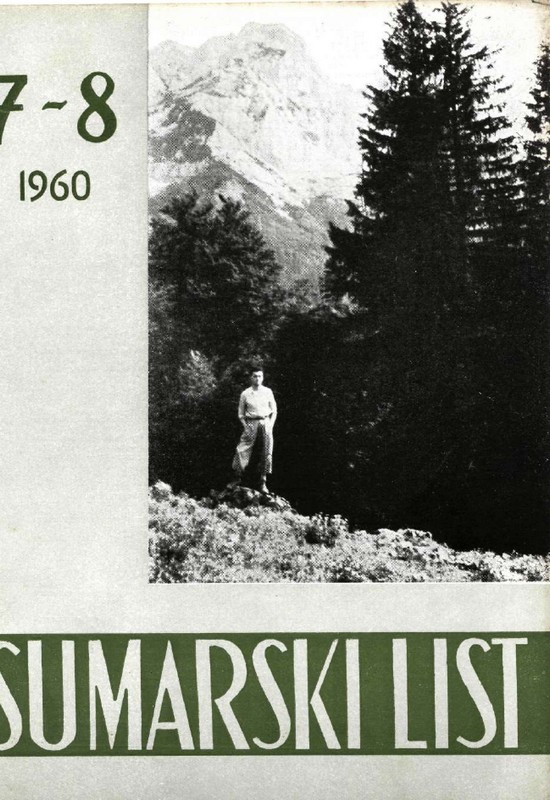
broj: 7-8/1960
pdf (13,6 MB) |
|
||||||||||||||
| PERSPEKTIVE RAZVOJA ŠUMOPRIVREDE JUGOSLAVIJE | ||
| Petrović Ljubomir, Mihajlović Novak | ||
| The role and tasks of engineers and technicians of forestry and timber industry in the further development of the communal systemas well as in the futherance of the forestry and timber industry PDF | 193 | |
| Bura Dimitrije | ||
| Organization of modern forest production (forestry) and new achievements in science and engineering. PDF | 198 | |
| ZAŠTITA ŠUMA | ||
| Androić Milan | ||
| Argyresthia fundella F. R. — A moth of Fir needles — the causative agent of the dying back of Fir in Gorski Kotar. PDF EN | 203 | |
| RAZNO | ||
| Eić Nikola | ||
| Perućica — our virgin forest sanctuary. PDF DE | 216 | |
| UZGAJANJE ŠUMA | ||
| Podhorski Ivo | ||
| Raising Poplars in »captage« plantings. PDF DE | 220 | |
| RAZNO | ||
| Vučković Nikola | ||
| Juridical considerations from the field of forestry. PDF DE | 223 | |
| UREĐIVANJE ŠUMA | ||
| Klepac, Dušan | ||
| An old practical method for the calculation of increment in selection forets. PDF FR | 228 | |
| FITOCENOLOGIJA | ||
| Gajić Milovan | ||
| Some characteristics of the plant community Querceto-Carpinetum Serbicum Rudski. PDF DE | 231 | |
| UZGAJANJE ŠUMA | ||
| Vidaković Mirko | ||
| Effect of gamma-rays on the germinability of certain Conifer seeds. PDF EN | 235 | |
| Summary: Radiated with gamma rays were the seeds of Scots Pine, Austrian Pine and Norway Spruce. The seed was radiated during 24 hours with a Co-60 - source of 0,9 C at the distances of 20, 30, 40, 50 and 60 cm, and doses of 82, 119, 187, 332! and 748 R-units. Other samples of the same seed were radiated with a Co-60 - source of 305 C, while the dosage was from 500 to 20.000 R-units as visible from Tab. 1. In this case all samples were radiated under equal geometrical conditions. Germinability for each dose was tested on 300 seeds while 600 seeds served as controls. The interval for testing germination was 40 days. The percentage of moisture was not measured. The radiated seed of Norway Spruce and Scots Pine was about 1 year old while the seed of Austrian Pine was about 3 years old. With doses from 82 to 2500 R-units the germination in Scots Pine was increased up to 96,30 % while in the controls it was 84,85%. In the Austrian Pine the control seed had a germination of 42,66 %. The increase of germination sets in at a dose of 748 R-units and goes on up to 3500 R-units. Within these dosing limits the highest germination is at 3000 R-units and amounts to 49 %. In the Norway Spruce the controls displayed a germination of 84,83 %, while the increase of germination in treated seeds sets in at a dose of 500 R-units, and keeps on (exceptig some deviations) up to 550 R-units. The maximum germination of 89,31 % was at a dosage of 4000 R-units. The mean time of germination Y as visible from Tab. 1 increases in all the three species with the increase of dosage (excepting some deviations). The dispersion of a around the mean time of germination (Tab. I.) is in small doses for all three species smaller than in their controls while in larger doses it is the converse. Only in Austrian Pine - in doses larger than 13000 R-units - is the dispersion of treated seeds smaller than that of the controls. The Scots Pine possesses at a dose of 14000 R-units a germination of 0,67 %, and we can consider this dose to be already the threshold of lethality. Yet at the dose of 20000 R-units the Austrian Pine and Norway spruce display a germination of 12,33 % and 28,67 % respectively. On the graphs is shown the number of germinated seed by days. The histograms represent the germinating power for the first 7 and 14 days respectively. In Norway Spruce the germination power for the first 7 days is higher at doses of 187, 332 and 748 R-units, while in other doses it is lower than in the controls. In Scots Pine the germinating power in the first 14 days in doses up to 2500 R-units is higher than in the controls, while in larger doses it is lower. In Austrian Pine the germinating power at small doses is approximately equal to that of controls. In a dose of 748 R-units the germinating power is somewhat higher than that of the controls, whereafter it decreases. Consequently it can be concluded that by radiation with small doses the germinating power of seeds of Norway Spruce, Scots Pine and Austrian Pine is increased. Scots Pine displays in this case the greatest regularity. The smallest increase of germinating power occurs in Austrian Pine, whose seed was the oldest. It can be supposed that with the ageing of seeds the radiation with small doses can only effect a very small increase in the germinating power. The seed radiated with 5000 R-units (see Table and Graphs) shows a great deviation; therefore data should be taken with grain of salt, while the experiment should be repeated. | ||


